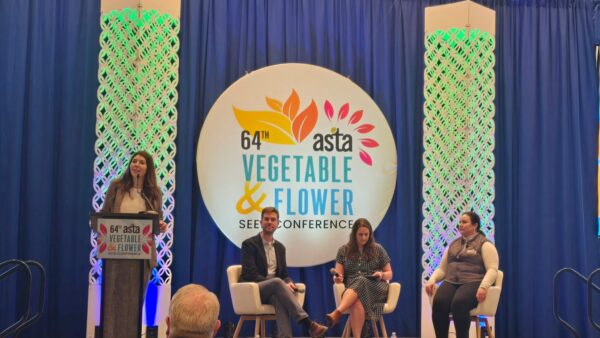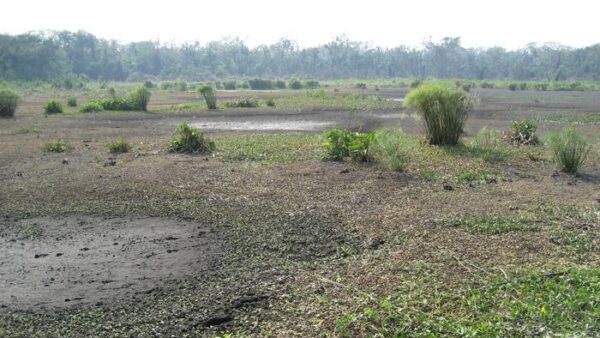Gene editing and climate change were major topics on the agenda at this year’s meeting of the Prairie Grain Development Committee.
_x000D_
When federal research scientist Tom Fetch opened a copy of National Geographic a few months ago, he knew then what the topic of this year’s Prairie Grain Development Committee (PGDC) annual meeting would be._x000D_
_x000D_
“The article was about DNA, and it talked about CRISPR and gene editing. We’re all aware of biotech and GMO, but this is being heralded as something cutting-edge and really different,” Fetch said._x000D_
_x000D_
Taking place Feb. 27 to March 2 in Winnipeg, the PGDC devoted its annual plenary session to the issue of gene editing and climate change, which both have an impact on what members of the committee do._x000D_
_x000D_
The PGDC acts as a forum for the exchange of information relevant to the development of improved cultivars of grain crops for the western Canadian prairies, and advises regulatory agencies about legislation and regulations governing grain breeding, cultivar production, and sector development._x000D_
_x000D_
This year, 43 cultivars in four different crop categories were recommended for registration, delivering even more options for stakeholders throughout the agriculture sector and beyond._x000D_
_x000D_
The plenary session, featuring four speakers, helped frame discussion around what the future might hold and how various crops could be affected. Fetch says gene editing is something that has the potential to take breeding to a whole new level, and have a big impact on the PGDC._x000D_
_x000D_
“Is it going to revolutionize what our breeders do? I’d say yes,” he says._x000D_
Tweaking the Genome
_x000D_
Focusing on new gene editing tools, Agriculture and Agri-Food Canada researcher Stacy Singer highlighted how revolutionary they really are in terms of altering plant genes, while not creating actual GMOs in the process._x000D_
_x000D_
“We’re talking about targeted mutations done in a highly specific manner,” she said in reference to technologies like clustered regularly interspaced short palindromic repeats (CRISPR), which allows researchers to edit plant genes without introducing any foreign genetic material, something Singer noted is a big reason behind public opposition to GM technology._x000D_
_x000D_
“[CRISPR] yields genetic alterations indistinguishable from those obtained through conventional breeding approaches. Theoretically one would think this means they should be regulated the same as conventionally bred crops, but that’s not necessarily the case.”_x000D_
_x000D_
Speaking to the regulatory angle, Canadian Food Inspection Agency plant biosafety management analyst Heather Shearer said Canada’s regulatory system favours new gene editing technologies like CRISPR._x000D_
_x000D_
“We’re on the cusp of exciting times in agricultural biotech. The question for me as a regulator is, ‘Is our system up to the challenge?’ I feel we do have the flexibility to roll with the times,” she said._x000D_
_x000D_
“We take a case-by-case approach. Each product is different — we don’t have a prescriptive system where we say, ‘If you use gene editing, you’re going to be regulated.’ It gives a lot of flexibility, but it does create uncertainty for people creating new varieties.”_x000D_
_x000D_
However, she noted that some of the most important advances in plant breeding have really just been about combining existing traits in useful ways and improving yields by bringing the best traits together._x000D_
_x000D_
“Gene editing can be used to do this. You can in theory rearrange a genome to link useful traits together. That might not be regulated by [the federal government]. If all you’ve done is rearrange a genome, there’s nothing new there, and we shouldn’t be involved.”_x000D_
_x000D_
_x000D_
But just because something isn’t regulated, doesn’t mean there won’t be public opposition. Francis Kirigwi, secretary for the PGDC’s Prairie Recommending Committee for Wheat, Rye and Triticale (PRCWRT), said technology involving the genome has received enough public opposition that it remains to be seen how open consumers will be to new breeding techniques._x000D_
_x000D_
“At what point will the public come to accept a modification in a staple crop like wheat? It’s a big question, whether the public consensus will be for us to go in that direction. CRISPR may help to persuade a lot of people,” he said._x000D_
_x000D_
There is still a lot of work to be done, Kirigwi noted, and added it’s not as simple as using CRISPR to go in and make tweaks to the wheat genome to create exciting new varieties. The recent mapping of the wheat genome (done with the help of PRCWRT chair Curtis Pozniak) will no doubt help, he said, but researchers have a ways to go._x000D_
_x000D_
“You still have to identify the genes you want to edit. There is still a lot we don’t understand,” he said._x000D_
Clouding the Water
_x000D_
Not all PGDC members were hailing gene editing techniques as the next big thing for their respective crops. Glen Hawkins, chair of the Prairie Recommending Committee for Pulses and Special Crops (PRCPSC), said the pulse varieties on the market have been developed through conventional breeding, and right now there’s no appetite on the part of industry or consumers for pulses modified through gene editing._x000D_
_x000D_
“In terms of our markets in Europe and China and Japan, as soon as you put gene editing in the picture, it clouds the water in a hurry and creates another level of complexity you have to deal with,” he said._x000D_
_x000D_
“We’re making good gains as it is. Unless we come up against something where we have no alternative but to use gene editing technology, I can’t see it happening. Plus, those technologies are pricey. There’s not enough money in pulses right now to even think about that. Unless you’re in corn and soybeans — the big-money crops — you can’t even begin to ask yourself those questions.”_x000D_
_x000D_
_x000D_
It’s not just corn and wheat that’s being used as a vehicle for gene editing techniques, though. Gene editing has started to work itself into plants like flax, noted Prairie Recommending Committee for Oilseeds (PRCO) chair Eric Fridfinnson. The Canadian flax industry worked with California-based Cibus to develop the first non-transgenic (non-GMO) glyphosate tolerant flax seed, which used gene editing in its development process._x000D_
_x000D_
“It holds great promise, I think,” Fridfinnson said. “The regulatory issues are our next challenge. Gene editing is considered mutagenesis in Canada and the U.S. In Europe it’s mutagenesis too, but it’s considered new technology of course, and you’re dealing with the public and their willingness to accept it.”_x000D_
_x000D_
Rich Joy, chair of the Prairie Recommending Committee for Oat and Barley (PRCOB), said that gene editing holds promise for the barley sector._x000D_
_x000D_
“It’s going to reinvent the thought process from the general public in regard to, ‘OK, so this isn’t a GMO.’ We’re just modifying what is already there to improve it. Once you get that across, I think it will affect public perception in a positive way,” he said._x000D_
_x000D_
“We will definitely see it in our barley group. I’m cautiously optimistic we’ll get some benefit out of this.”_x000D_
Changing Climate
_x000D_
Another benefit of gene editing is its ability to create varieties better suited to the effects of climate change, Singer said._x000D_
_x000D_
But University of Manitoba agrometeorologist Paul Bullock, who also spoke at the plenary session, said the ag industry will have to be careful when it comes to adapting to climate change._x000D_
_x000D_
He said climate data is spacially inconsistent, and showed a variety of study results from Canada that paint an unpredictable picture when it comes to drawing conclusions about what growing conditions of the future will be like._x000D_
_x000D_
“Climate trends are driving the decisions we’re making in [farming]. You might plan using the trend, but things can vary greatly. You can’t predict it. You don’t know what your frost-free period is going to be next year. Some people might try to sell you that information for a lot of money, but I’d be keeping that money in my pocket,” he said._x000D_
_x000D_
“You can’t look at climate change and say, ‘Based on this, here’s what we should be doing in agriculture.”_x000D_
_x000D_
Still, he noted there will be a desire in the future for longer-season crops._x000D_
_x000D_
Hawkins said the PRCPSC is keeping climate change in mind for the future._x000D_
_x000D_
“If we face flood or drought, it creates challenges, and we may have to adapt to that by selecting our lines differently. Climate change isn’t going to just hammer us overnight — it’s a gradual thing, and we’ll do our best to adapt to the conditions we see ourselves in.”_x000D_
Record Crowd
_x000D_
It was a record year for the PGDC meeting in terms of attendance, according to Fetch, with 300 registrants._x000D_
_x000D_
“That’s exciting, and I think part of the reason was the plenary session,” he said._x000D_
_x000D_
The breakdown of cultivars recommended for registration was:_x000D_
_x000D_
PRCWRT: 13 wheat lines, 2 rye lines, 1 spelt line, 2 durum lines_x000D_
_x000D_
PRCOB: 4 oat lines, 6 barley lines_x000D_
_x000D_
PRCO: 1 flax line, 2 mustard lines_x000D_
_x000D_
PRCPSC: 7 dry bean lines, 2 faba bean lines, 3 yellow pea lines, 2 green pea lines, 2 lentil lines_x000D_
_x000D_
For minutes and other data from the 2017 meeting visit pgdc.ca.















